TCFI Gen 5 System
$1,227.75 – $1,236.75
TCFI Gen 5 Fuel Injection Controller for CAN Bus Models Including 2012-2017 Dyna® and Softail® and all 2014 & Later Except Touring Models
Description
TCFI Gen 5 Fuel Injection Controller for CAN Bus Models Including 2012-2017 Dyna® and Softail® and all 2014 and later Except Touring Models

· Fully programmable plug-in replacement for 36 pin Delphi® controller with J1850 data bus. Not compatible with 2008 and later touring models with electronic throttle control. Not compatible with 2011 and later models with CAN data bus
· Quickly auto-tune fuel curves for front and rear cylinders on a dyno or on-road with new WEGO IIID dual channel wide-band oxygen sensor interface
· Robust alpha-N (throttle position and RPM based) fuel control eliminates problems with long duration/high overlap camshafts
· Powerful Windows software for custom programming and data analysis
· Extended data logging and diagnostics. DataFLASH memory stores full 60 minutes of operating data at 10 samples/second.
· Powerful Windows software for custom programming and data analysis
· Programmable user input for functions such as two stage RPM limiter, nitrous retard, and shift kill (not available in TCFI EX version)
· Programmable user output for functions such as shift light, nitrous activation, and electric shifter (not available in TCFI EX version)
· Billet aluminum housing with black anodized finish
· Easy plug-in installation
TCFI 5 Quick Start Guide
TCFI 5 Install Guide
TCFI 5 Manual
TCFI 100KPA Tech Note
TCFI 300KPA Tech NoteVisit the TCFI Tech FAQ for more detailed information about using the TCFI in performance applications!
The TCFI kit includes the WEGO IIID dual channel wide-band exhaust gas oxygen interface that allows quick auto-tuning on a dyno or on-road during actual riding conditions. The kit includes Bosch LSU 4.2 wide-band sensors for both front and rear cylinders. The user programs a table with the desired air/fuel ratios – the system then does the rest.
The TCFI solves tuning problems with highly modified engines. Competitive “band-aid” products that interface to the Delphi® controller still rely on speed-density fuel control. Long duration/high overlap camshafts wreak havoc with manifold pressure – especially at idle and cruise RPM. Speed-density based fuel control simply can’t cope.
High-end automotive racing systems use alpha-N (throttle position and RPM based) fuel control. Alpha-N eliminates any dependence on manifold pressure and is unaffected by long duration/high overlap camshafts. The TCFI brings this proven technology to the H-D® marketplace.
The TCFI has the same ignition control as our proven TC88/TC88A Twin Cam ignition systems with fully programmable advance curves. Idle air control including idle RPM and cold start characteristics are also fully programmable. This facilitates the use of throttle bodies modified for higher airflow.
New H-D® motorcycles use the SAE J1850 data bus for communications between the engine control module (TCFI), instrument cluster, and turn signal/security module (TSM/TSSM). The TCFI fully supports this new J1850 data bus. The TCFI also has built-in data logging that stores data for the last 60 minutes of operation at 10 samples/second. A USB interface and Windows compatible software allow the use of a laptop PC for programming and data analysis. The USB interface plugs into the existing H-D® diagnostic connector on the motorcycle wiring harness.

TCFI Installation
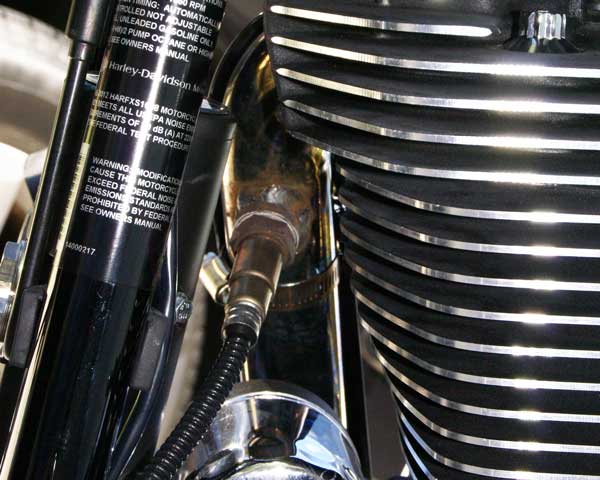
Wide-Band Oxygen Sensor on Front Pipe
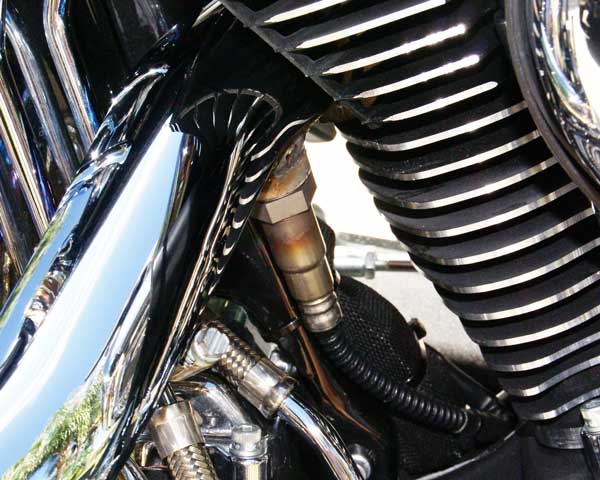
Wide-Band Oxygen Sensor on Rear Pipe
The TCFI is intended for high performance race engines that are expected to produce over 100 HP. The TCFI has been tested on engines up to 145 CID and 170 HP. We provide setup tables that will get you up and running. From a practical standpoint, tuning any fuel injection system requires an exhaust gas analyzer. You can either spend a lot of time on a dyno with an exhaust sniffer (like the newer Dynojet units) or you can use our WEGO. With the WEGO, the system will auto-tune the fuel tables while you ride the bike – you won’t need to spend any time on a dyno. Auto-tuning under actual riding conditions only takes a few hours and gives much more realistic results that dyno tuning. Air-cooled engines are very sensitive to thermal effects and dyno systems generally have inadequate cooling airflow.
The TCFI EX is 50 states street legal (ARB E.O. No. D-641-5) for 2001-2006 88 CID Twin-Cam with 36 pin Delphi® system, excluding 2006 Dyna models with original equipment oxygen sensors. The TCFI EX is recommended for all street driven applications and allows retrofit of closed loop oxygen sensor technology to earlier models. There are only a few limitations compared to the standard race version TCFI. User changes to the air/fuel ratio table are only allowed above 2750 RPM or 35% throttle. There are also some limits on the range of user changes to the spark advance table. The programmable user input and output functions are not available.
PC Link Software for Programming Custom Advance and Fuel Tables
PC Link software runs under Microsoft Windows XP/Vista/7/8. We no longer support older Windows versions. PC Link allows the user to program all the engine control tables and parameters within the Twin Tec TCFI system. Minimum PC requirement is a 300 MHz Pentium with super VGA display (SVGA with 1024 x 768 pixel resolution). The TCFI connects to the PC by means of a USB interface. A USB cable is supplied with the unit. The PC must have a free USB port.
3D tables are used for ignition advance and fuel control. Additional 2D tables are used for functions such as cold start enrichment and idle air control. Some sample tables are shown below.
On 2004 and later models using the new J1850 data bus, the ECM (engine control module) converts signal pulses from the VSS (vehicle speed sensor) to data that is transmitted to the instrument cluster. Scaling (in terms of VSS frequency/speed) varies slightly between models depending on tire size and gear ratio. You can use PC Link software to change the default scaling and recalibrate the speedometer/odometer. For more detailed information, we suggest that you download the software and instructions.
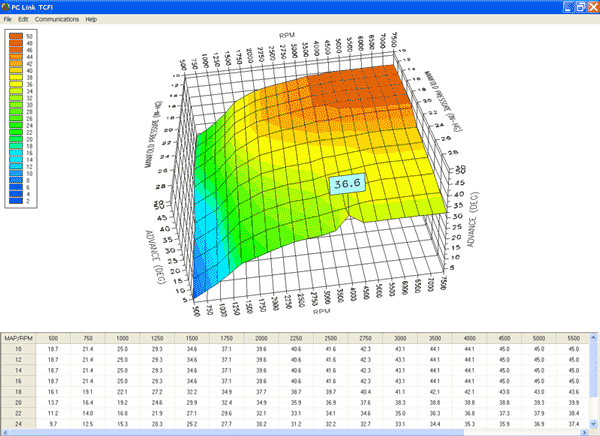
Sample 3D Ignition Advance Table

Sample 3D Air/Fuel Ratio Table
![]()
Sample 2D Idle Speed Table
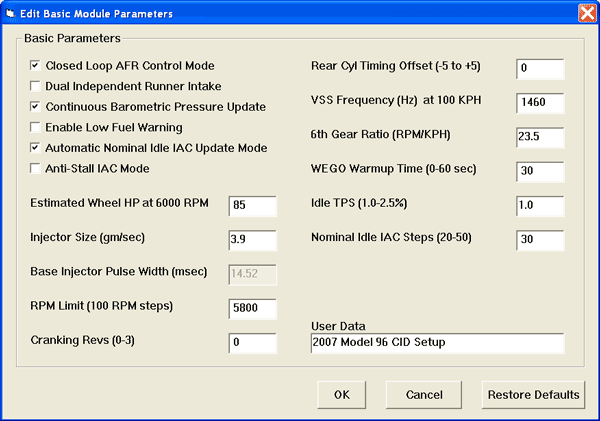
Sample Engine Control Parameters Screen
The TCFI also features a user input and user output that can serve various functions. The user input can be configured for data logging (such as the status of a switch), ignition retard, ignition kill (for air shifter), or stage RPM limit. The user output can drive a relay and be configured as a general purpose RPM and throttle position based switch or to trigger an NOS system.
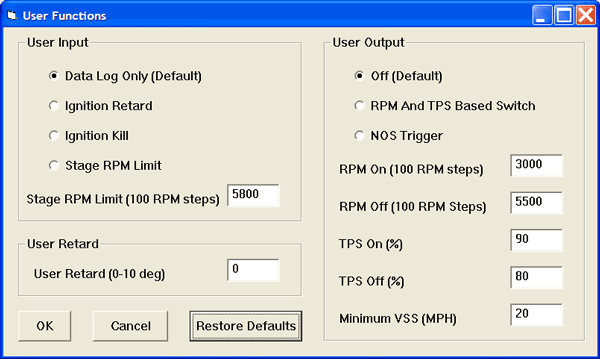
User Functions Screen
PC Link software is free! You can always download the latest version of the software and instructions (contained within the TCFI Installation & Tuning Manual) from our website. The software will run in demo mode without a TCFI system attached. For your convenience, For your convenience, we include all of our software online for you to download at anytime. Refer to the links above or go to our software page.
TCFI Data Logging Software
The TCFI features comprehensive data logging capability. During dyno testing, you can display real time engine data on an instrument panel type screen. The TCFI stores data for the last 60 minutes of operation at 10 samples/second. You can download and display this data on a chart recorder type screen. Data is available for all sensor inputs and output functions. The TCFI data logging capability greatly facilitates fine tuning and diagnosis of driveability issues. The data logging software, TCFI Log, has the same PC requirements as described above for the PC Link software. For more detailed information, we suggest that you download the TCFI Log software and instructions. The software download includes a sample file with actual data.
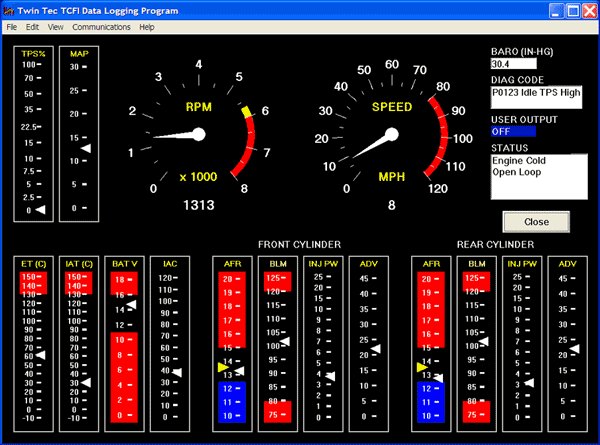
Real Time Engine Data Display
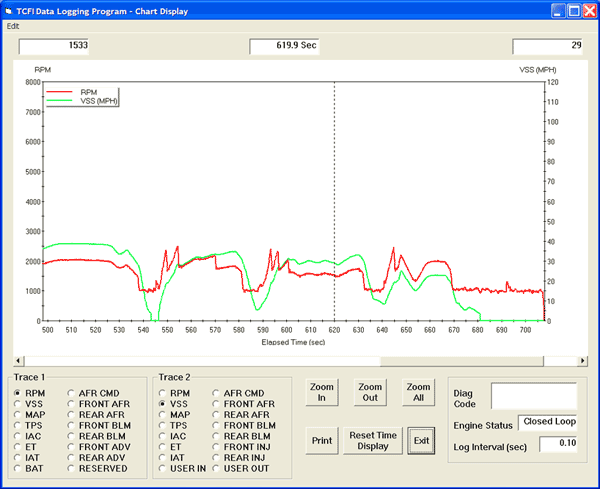
Data Logging Chart Display
The data logging software also allows you to download operating statistics and historical diagnostic codes. Downloaded operating statistics are displayed as shown below. Total hours represents the total time that the engine was running. ID represents the firmware identification. This field typically includes the manufacturer (Twin Tec), model number, program revision and author’s initials, and date. Elapsed time is displayed for 13 RPM bands from idle to 6999 RPM. The utility also displays the maximum engine RPM, time at the RPM limit (in seconds for better resolution) and the number of engine starts. All this data can be printed to provide a permanent record. The data stored in the module for maximum engine RPM and time at the RPM limit can be cleared. All other elapsed time and engine starts data is permanent.
Any historical diagnostic codes logged by the TCFI are listed along with the number of trips (engine start cycles) since the individual code was last logged. The software can also clear diagnostic codes.

Operating Statistics Data
The elapsed time data in the various RPM bands can be displayed in the form of a histogram chart by clicking on the Histogram button. Clicking on this button causes the chart shown below to appear. Color coding of the bars helps to interpret the data. The idle RPM band is blue, normal operating RPM bands are green and high RPM bands are yellow and red. The chart is automatically scaled for best display.
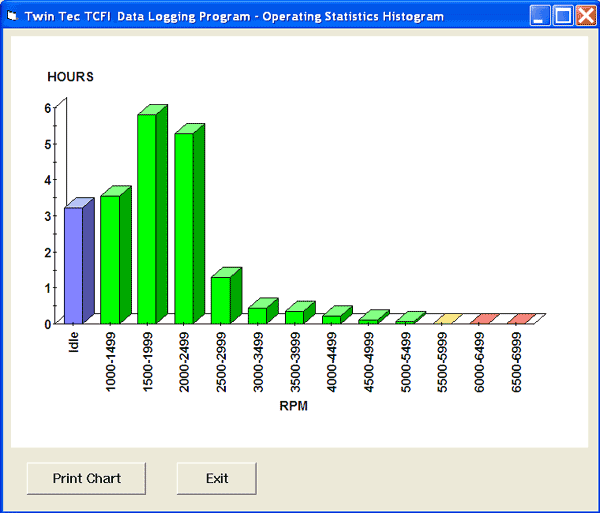
Operating Statistics Histogram Chart
TCFI Log software is free! You can always download the latest version of the software and instructions (contained within the TCFI Installation & Tuning Manual) from our website. The software will run in demo mode without a TCFI system attached.For your convenience, we include all of our software online for you to download at anytime. Refer to the links above or go to our software page.
Additional information
| Weight | 7.00 lbs |
|---|---|
| Dimensions | 6.00 × 8.00 × 15.00 in |
| Choose Your Model | TCFI Gen 5 System, 2014 -2017 Sportster® models with CAN data bus (+ $9.00), 300 KPA Speed Density for Supercharged CAN bus models including 2012-2017 Dyna® and Softail® (+ $1.00), 100 KPA Speed Density for Supercharged CAN bus models including 2012-2017 Dyna® and Softail® (+ $1.00) |



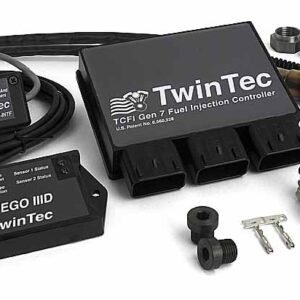
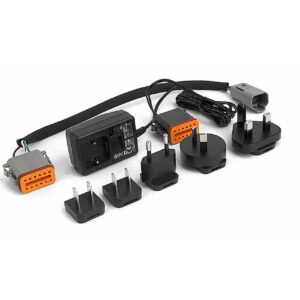
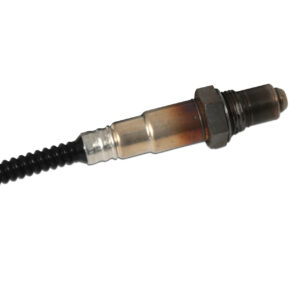
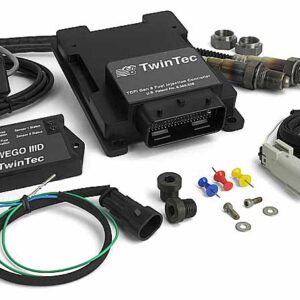

Reviews
There are no reviews yet.